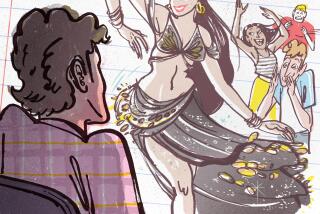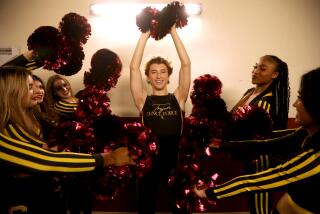A new twist in belly dancing
- Share via
CAIRO -- Farid Mesbaah, male belly dancer, hopped on a car in Cairo’s Shobra district and strutted his stuff.
He clanged metal castanets, magically converted his hips into pistons and twirled his head around like a centrifuge. The crowd at tables lining a dirt alley clapped rhythmically. Young men in jeans jumped up to wiggle along.
Mesbaah was performing at the opening of the Old-Time Moon Cafe, a gig that -- along with weddings, birthdays, night clubs and circumcisions -- is typical for belly dancers. Not typical, at least in recent years, are performances by men.
Male belly dancing, a centuries-old Egyptian tradition, is making a comeback -- against the odds, considering its periodic suppression by government and religious officials. The problem for Mesbaah is that his craft has long been associated with homosexuality -- a taboo in Egypt.
“I just like to dance,” says Mesbaah, who has seven children. “It’s very sensual. I’ve been doing it since I was little.”
Mesbaah is shimmying in a society that has long struggled with ever-changing limits of social tolerance. A carved relief at a Pharaonic-era tomb near Cairo shows today’s dance prohibitions were yesterday’s norm. It depicts a chorus line of men at a religious festival; each wears a sash knotted on his left hip, a fashion for dancing men and women that lingers today.
Male performers were once considered more reputable than females. In his book “The Manners and Customs of the Modern Egyptians,” Edward William Lane, an Englishman and prominent Arabic scholar who lived in 19th century Cairo, observed that male dancers were preferred by Cairenes who thought women “ought not to expose themselves.” From 1834 to 1849, female dancers, known as ghawazee, were banned from the city.
Rakia Hassan, 62, a retired dancer, recalls that in her childhood, males peddled their skills along with women on Muhammad Ali Street, then a one-stop shop for belly-dancer hires.
“It became a business like any other, and men were part of it,” she says. “You know, Egyptians love to dance -- boys, girls, whatever -- so it was not unusual. However, Islamic trend has made it more difficult for the men.”
During the reign of Gamal Abdul Nasser, male belly dancing all but disappeared because it smacked of monarchical decadence. Nasser took over Egypt in 1954, two years after King Farouk was overthrown by military officers.
No one knows the number of male -- or for that matter, female -- dancers now. There is no belly-dance association, an indication of the profession’s seedy reputation. (Belly dance is a Western term invented by the French; Egyptians call it simply Oriental or “homegrown” dance.)
Male dancing, along with officially proscribed activities such as open prostitution and smoking hashish, goes on in some nightclubs. Mahmoud Karim, 20, who dances in discos along Pyramids Street, says he pretends to be an enthusiastic customer but actually gets paid by clubs to perform.
“Just in case someone objects, the owner says I’m an amateur,” he says.
Tolerance for male dance doesn’t mean tolerance for homosexuality -- even among the dancers, who have been known for at least 150 years by an Arabic word, khawal, now an insulting slang for gay men.
Gay life is dangerous in Cairo, where plainclothes police are on the lookout for hustlers on the streets. In 2001, police raided the Queen Boat, a floating dance hall, and arrested 52 men for “debauchery” and “perverting religion.”
“I’m careful not to look like I’m seducing customers,” Karim says.
Tito Seif, a well-known belly dancer whose performances are available for viewing on YouTube, dances only in the galabiyah, a slack caftan, never in anything revealing.
“I don’t believe that a male belly dancer should imitate a woman,” says Seif, 35. “We should not forget we are men and dance in a manly way.”
He says he will leave Egypt to dance abroad because the current crop of male dancers “is giving us a bad reputation.”
Samia Allouba, 45, a belly-dance instructor, admires male dancers -- to a point. “Definitely, they can move,” she says. “As long as they don’t try to imitate women. That I find disgusting.”
Mesbaah jokes that female dancers are jealous of the men. “We can do more with our muscles,” he says. He turned his passion into a profession 10 years ago after ending a career as a metal worker.
When performing, he is on the lookout for possible hostility. “If I think the audience is unfriendly, I just leave,” he says.
He dresses in loose black trousers and T-shirt; no pantaloons, vests or skirts recalling the khawal past. The only accessory linking him to belly-dance dress is the waist scarf.
His family accepts his profession, except for an older brother who, Mesbaah says, is a devout Muslim and has stopped talking to him.
“Some people think it’s forbidden, but we Egyptians like to have fun,” he says.
Still, Mesbaah says he has refused to dance on film because it might hurt the marriage chances of his three daughters. He also doesn’t want any of his four sons to follow in his steps.
“I’d like them to do something else,” he says. “Be better than me.”
More to Read
Sign up for Essential California
The most important California stories and recommendations in your inbox every morning.
You may occasionally receive promotional content from the Los Angeles Times.










